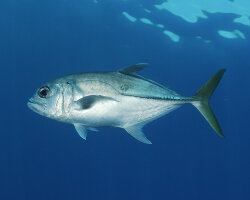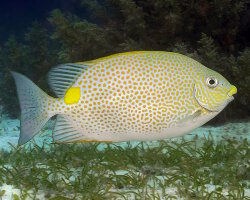Sealife guideThe peacock flounderBothus lunatus
Taxonomy
- Common name: Peacock flounder
- French name: Sole tropicale, carrelet tropical
- Spanish name: Lenguado lunado
- Scientific name: Bothus lunatus (Linnaeus, 1758)
- Family name: Bothidae
- Order name: Pleuronectiformes
- Class name: Actinopterygii
Description
The peacock flounder generally measures around 8 inches, with a maximum length of 18 inches. The peacock flounder, which is grayish-white to brown in color, has numerous circular spots bordered with blue across its body and blue dots on its fins.

Observe the camouflage of the peacock flounder against a predominantly dark background !
Range
The peacock flounder is found in the western Atlantic ocean, from Florida to Brazil, including the Bahamas and the many islands that make up the Caribbean arc, such as
Guadeloupe.
However, it is absent from the Gulf of Mexico. The peacock flounder is also present in the eastern Atlantic ocean around Ascension island and the Gulf of Guinea.
Habitat
The peacock flounder inhabits depths ranging from the surface to 328 feet but is more commonly found at around 65 feet. It frequents sandy bottoms around coral reefs.
Diet
The peacock flounder feeds on small fish, crustaceans and small octopuses.
Reproduction
The peacock flounder reproduces sexually.
Did you know ?
The peacock flounder has an impressive ability to adapt its camouflage to its habitat. In a fraction of a second, the peacock flounder can change from brown to grayish-white depending on the dominant color of the background !
The peacock flounder is listed as many other marine species within The
IUCN Red List of threatened species. The peacock flounder appears in the
IUCN Red List since 2015 within the category Least Concern !
Tips for observing
Blending in with the substrate it rests on, the peacock flounder is hard to spot, so patience is required to thoroughly search seemingly lifeless sandy bottoms !

Observe the camouflage of the same peacock flounder but now against a light-colored sandy background !
Once you spot it, keep a close eye on it, as it will be difficult to relocate again !
Explore also

Seale's cardinalfish
(Ostorhinchus sealei)
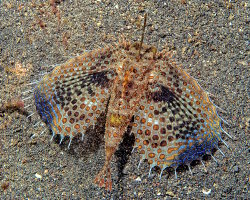
Flying gurnard
(Dactylopterus volitans)
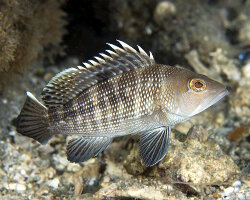
Black sea bass
(Centropristis striata)

Barred-fin moray eel
(Gymnothorax zonipectis)
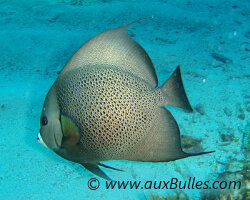
Gray angelfish
(Pomacanthus arcuatus)

Halimeda ghost pipefish
(Solenostomus halimeda)

Midnight parrotfish
(Scarus coelestinus)

Yellowfin tuna
(Thunnus albacares)
The marine species from Caribbean sea
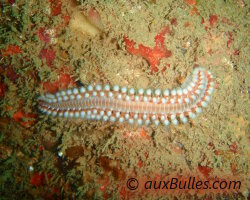
Bearded fireworm
(Hermodice carunculata)
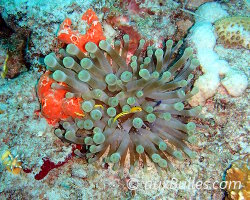
Giant caribbean anemone
(Condylactis gigantea)
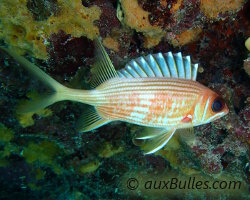
Longspine squirrelfish
(Holocentrus rufus)
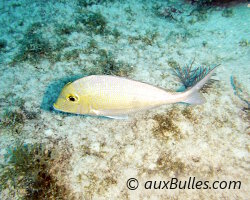
Saucereye porgy
(Calamus calamus)

Spotted spiny lobster
(Panulirus guttatus)
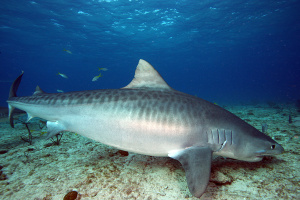
Tiger shark
(Galeocerdo cuvier)
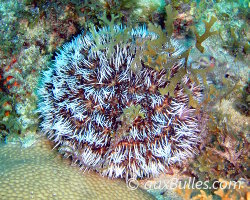
West Indian sea egg
(Tripneustes ventricosus)
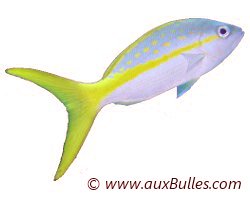
Yellowtail snapper
(Ocyurus chrysurus)
Dive centers
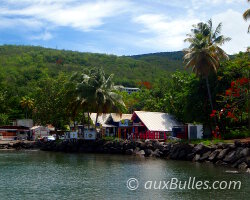
'Les Ilets' dive center
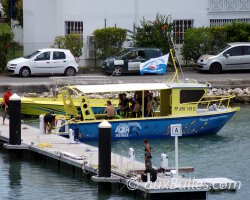
Noa dive center






















